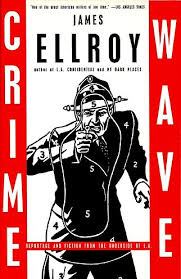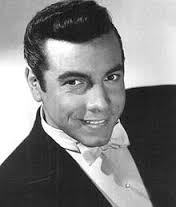James Ellroy’s Denver Film Series: In a Lonely Place
For the following piece we welcome back to the blog James Ellroy aficionado and all-round good guy Jason Carter. Here’s Jason’s bio:
Jason Carter is an unofficial Ellroy scholar with 20-years of Ellrovian tutelage under his belt. A devoted follower of Ellroy since the age of 14, Jason now has the enviable honor of calling Mr. Ellroy his friend. Although, don’t think of asking Jason for any personal details about Ellroy, as Jason is ferociously protective of Mr. Ellroy’s privacy. Jason, like Ellroy, lives in Denver, Colorado.
“Woof, woof—hear the Demon Dog bark—he’s got a twelve-inch wanger that glows in the dark. I’m the king of writers, woof woof, woo woo, I got a 12-year-old girlfriend strung out on glue. I’ll end this poem and beat my meat, because, cats, tonight, you’re in for a treat…”
Thus began James Ellroy’s introductory comments on the 11th installment of his award-winning monthly Denver film series. This month’s offering was In a Lonely Place, a 1950 film noir directed by Nicolas Ray, and starring Humphrey Bogart and Gloria Grahame. The Denver film series is named ‘In a Lonely Place’ after this classic noir, so to hear Ellroy finally give his take on the movie was very special. Over the past year, Ellroy’s series has delivered cinematic masterpieces as diverse as Akira Kurosowa’s High & Low, Alfred Hitchcock’s Vertigo, Robert Altmann’s Nashville, the Coen brothers’ Miller’s Crossing and Bo Widerberg’s The Man On the Roof, all preceded by Ellroy’s incomparable commentary.
I once said on this blog that the films Ellroy selects reflect the passionate crimes of the heart which dominate his novels. This is certainly true, but I’ll include that such a sundry lot also dynamically demonstrates the breadth and depth of James Ellroy’s interests and imagination. Ellroy is right when he says he is no longer a crime writer, but a historical novelist… Ellroy certainly knows the story of man, and is never afraid to tell it from the most savagely honest perspective imaginable. If only Ellroy’s detractors could see him like this, they would witness an intellectual passion that runs far deeper than any of Ellroy’s infamously profane Demon Dog performances. (I’m looking at you, Mike Davis!)
“In a Lonely Place the movie is not as good as its source material,” Ellroy continued, referencing Dorothy B. Hughes seminal crime novel. Ellroy was less flattering when describing Bogart. “Bogie was a pissed off little guy nobody would ever mistake for a good guy,” Ellroy intoned, adding “Bogie was, at that time, the Daffy Duck of male movie stars… he thinks he’s cool, but really isn’t.”
In A Lonely Place tells the story of Dixon Steele (Bogart), a has-been Hollywood screenwriter with an explosive temper. Steele takes a coat check girl home with him, and the very next day the girl is found murdered. Steele is interrogated as the prime suspect as he was spotted with the victim by his neighbor Laurel Gray (Grahame). Gray is also brought to the police station, confirms the girl left Steele’s home unharmed, and Steele is released. As Steele and Gray slowly begin a relationship, Steele’s writing ability recovers, and he dives into his work. However, Steele begins to act strangely, and even forces an old army buddy and the man’s wife to participate in a bizarre re-creation of the murder based on the known facts of the case. The police captain who interrogated Steele shows Steele’s lengthy record of erratic and violent behavior to Gray, who, accordingly begins to doubt Steele’s innocence. The film ends with an eleventh-hour twist and the tragic specter of a future which cannot be built on the destruction of the past.
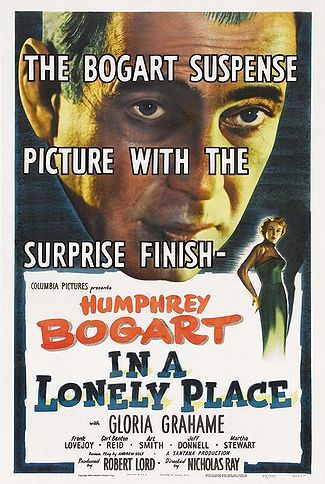 “The movie showcases the great L.A. iconography on top of everything else,” Ellroy said in his introduction. Part of that iconography is most certainly the grand isolation and hapless verisimilitude of celebrity, topics which Ellroy has explored in his novels for decades. As Ellroy himself said in My Dark Places, “Isolation breeds self-pity and self-loathing”; both of which are on abundant and yet subtle display in Humphrey Bogart’s Dixon Steele, who at one point even says “There’s no sacrifice too great for a chance at immortality…”
“The movie showcases the great L.A. iconography on top of everything else,” Ellroy said in his introduction. Part of that iconography is most certainly the grand isolation and hapless verisimilitude of celebrity, topics which Ellroy has explored in his novels for decades. As Ellroy himself said in My Dark Places, “Isolation breeds self-pity and self-loathing”; both of which are on abundant and yet subtle display in Humphrey Bogart’s Dixon Steele, who at one point even says “There’s no sacrifice too great for a chance at immortality…”
Ellroy was no less sparing of Gloria Grahame, and director Nick Ray, who were married at the time In A Lonely Place was made. “Nick Ray put evil clauses in the film contract Gloria had to abide by,” Ellroy said, referencing contract stipulations dictating that “my husband [Ray] shall be entitled to direct, control, advise, instruct and even command my actions during the hours from 9 AM to 6 PM, every day except Sunday…I acknowledge that in every conceivable situation his will and judgment shall be considered superior to mine and shall prevail.” Grahame was also forbidden to “nag, cajole, tease or in any other feminine fashion seek to distract or influence him.”
Their marriage would not survive the filming. Afraid that one of them would be replaced, Ray began sleeping in a dressing room, under the pretext that he needed to work on the script. Grahame acquiesced, and nobody on the set knew of the separation. Though they briefly reconciled, they would divorce in 1952, after Ray found Grahame in bed “doing the bad boogaloo” with his thirteen-year-old son, a part of the story Ellroy had particularly savage fun in re-telling.
After the film, we gathered in the theater’s bar to discuss it, which has always been my favorite part of every one of Ellroy’s film screenings. With Ellroy at the helm as a deft master of ceremony, the conversations which develop can often become as wonderfully convoluted as any of the plotlines from his novels. Even when jet-lagged (Ellroy had just returned to the states after a visit with his international publisher in France), the Demon Dog is still an indomitable force. On this particular evening, Ellroy regaled us with sordid tales from his roaring 20’s, including numerous run-ins with the LAPD. Speaking of running—don’t do it. “Never, ever run from the LAPD,” Ellroy warned us. “They’ll catch you, and kick your ass!” Ellroy then told us of a time when he ran after committing a petty theft.
“Ask me anything about politics or Hollywood,” Ellroy said, seamlessly shifting gears. One patron mentioned the Kennedy clan and Lyndon Johnson. “The Kennedys are stale bread,” Ellroy denounced. Ellroy does indeed have an encyclopedic knowledge of politics, Hollyweird, and all forms of sleaze in between. However, I’ve sworn never to repeat online most of what he’s told me.
I mentioned—to Ellroy’s surprise—that Curtis Hanson had shown In a Lonely Place to Guy Pearce and Russell Crowe as part of a mini film series to prepare the then-unknown Aussie actors for their roles in L.A. Confidential. (Ellroy actually began his Denver film series—in September, 2015—with L.A. Confidential.) Continuing in the Hanson vein, I told Ellroy I heard the Demon Dog had a blink-and-you’ve-missed-it cameo in Hanson’s 2000 film Wonder Boys. Ellroy said that yes it was true, adding with typical Ellrovian pizzazz, that the film’s crew put him up in a hotel swarming with bedbugs. We were quite shocked to learn of Curtis Hanson’s untimely death just one day later.
Eventually, the conversation came around to an assassination attempt on legendary L.A. gangster—and Ellroy mainstay—Mickey Cohen in which the Mickster jumped on his pet bull dog to protect him. (Both Mickey C. and the dog survived). I held up my DVD of Reinhard Jud’s 1993 documentary Demon Dog of American Crime Fiction, and asked Ellroy if this is what he meant when Ellroy said in the documentary how Mickey was good-natured, despite his profession. Ellroy grinned at me and chuckled, leaving the question as open to interpretation as the endings of most of his novels.
After 20 years, I should expect nothing less.
I was a fan THEN.
I’m still a fan NOW.
Curtis Hanson (1945-2016)
I was saddened to learn this morning of the death of film director and screenwriter Curtis Hanson. Hanson will forever be remembered for adapting (with Brian Helgeland) and directing the big screen adaptation of James Ellroy’s novel L.A. Confidential. Hanson had already built a reputation as a director with a brilliant grasp of genre with the thrillers The Hand that Rocks the Cradle (1992) and The River Wild (1994), before he began work on adapting what is perhaps Ellroy’s most complicated novel. Ellroy himself had said of L.A. Confidential:
I knew my book was movie-adaptation-proof. The motherfucker was uncompressible, uncontainable, and unequivocally bereft of sympathetic characters. it was unsavoury, unapologetically dark, untameable, and altogether untranslateable to the screen.
But for Hanson it was a labour of love, he said of Ellroy’s fiction:
Many find Ellroy’s novels unremittingly dark. I don’t. His humor and strength of personality shine through. He’s a survivor. Whether he intends it or not, that strength of spirit illuminates even the darkest of his nightmare visions.
The screenplay took some major deviations from the novel, all for the better in my opinion, making the narrative more linear and comprehensible for the screen. The fate of Jack Vincennes is completely different in the film than it is the novel, but rightly so as I’ll never forget the shock I felt the first time I saw the kitchen scene with Vincennes (Kevin Spacey) and Dudley Smith (James Cromwell), where Spacey fatefully whispers ‘Rollo Tomasi’.
It’s worth noting too that every time I watched an interview with Hanson I was struck by how kind and even-tempered he sounded, completely destroying the myth that the best directors are tyrants who have to mentally torture their actors to get the best performances. I imagine he was a joy to work with.
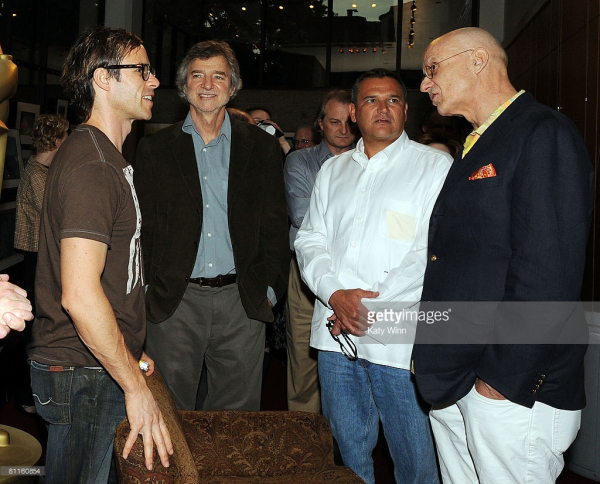
Curtis Hanson with Guy Pearce and James Ellroy
Hanson and Helgeland won an academy award for their screenplay adaptation of LA. Confidential, but shamefully the bauble for Best Picture that year went to James Cameron’s hammily acted, drearily written and thoroughly waterlogged Titanic. Hanson never quite matched the success of L.A. Confidential with his later films, but lets face it who could? I would highly recommend his comedy-drama Wonder Boys (2000), a charming but incisive portrayal of academe which has a blink and you’ll miss it cameo from Ellroy.
In any event if Curtis Hanson had never made another movie L.A. Confidential would still have been a big enough achievement for a lifetime. He took Ellroy’s unfilmable novel and turned it into a neo-noir masterpiece and one of the best crime films of all time. I’ll be watching it tonight for the umpteenth time in tribute to him, and perhaps I might feel a slight lump in my throat when Lynn Bracken (Kim Basinger) whispers in that irresistibly sexy voice ‘Some men get the world. Others get ex-hookers and a trip to Arizona.’
Thank you Curtis Hanson.
Mr Campion’s Fault – Review
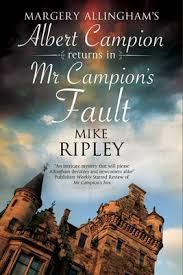 Continuation novels are a tricky business as an author is always likely to run in to an army of purists who will automatically dislike their work as infringing on the body of work of their literary hero. As much as I disapprove of this form of genre small-mindedness it does have a certain logic. I always enjoyed John Gardner’s James Bond novels for instance, although I have to concede they do not remotely touch the work of Ian Fleming.
Continuation novels are a tricky business as an author is always likely to run in to an army of purists who will automatically dislike their work as infringing on the body of work of their literary hero. As much as I disapprove of this form of genre small-mindedness it does have a certain logic. I always enjoyed John Gardner’s James Bond novels for instance, although I have to concede they do not remotely touch the work of Ian Fleming.
Mike Ripley’s decision to continue the Albert Campion series more than forty years after Margery Allingham’s death was at the very least a brave one. After all, Allingham was one of the most revered authors of the Golden Age and her aristocratic detective appeared in eighteen of her novels and countless short stories. The series was first revived by Allingham’s widower Philip Youngman Carter and Ripley’s first entry in the series, Mr Campion’s Farewell (2014), was the completion of a Youngman Carter manuscript. This was followed by Mr Campion’s Fox (2015) and now we have Mr Campion’s Fault.
In Mr Campion’s Fault the sudden death of the senior English master, Bertram Brown, of Ash Grange School for Boys brings Mr Campion to the fictional Yorkshire village of Denby Ash where his son Philip is coaching the school rugby team and his daughter-in-law Perdita has been trying to keep the late Brown’s long-planned musical production of Dr Faustus alive. Campion walks into an environment where miners are considered the upper classes, Methodism vies with local folklore about poltergeists as the dominant superstition, and northern bluntness is almost a foreign language to the well-heeled sleuth who begins to suspect that Brown’s death in a car accident may not have been so accidental after all. It’s not just Campion who found the setting alien. Any youngish British reader might believe they are reading about another world at times, but that, for me, was part of the appeal. I was enticed by descriptions of coal-mining in all its beauty and horror:
Mr Campion had gently steered the conversation to include the history and sociology of Denby Ash.
It had been, the headmaster had informed him, a pet theory of the late Bertram Browne that the people of Denby Ash were inextricably linked, economically and philosophically, to the seams of coal which ran under the village. With his background as a Sapper, the late Mr Browne had naturally taken an interest in matters geological and the ‘black gold’ on which the prosperity of the local population depended and whose bounty had been, in a way, responsible for the existence of Ash Grange School. There were those who found it whimsical that the long, subterranean solid rivers of coal were known as ‘Flockton Thick’ and ‘Flockton Thin’. Indeed, certain habitués of the Staff Room, who really should have known better, used the expression to describe formal gatherings of the Mothers’ Union, but not Bertram. He knew that Flockton Thick referred to twin seams each two-feet thick, whilst Flockton Thin was a 15-inch layer of coal of the very highest quality, and neither were laughing matters for down there, six hundred feet underground, the men of Denby Ash (and, a century ago, not a few women and children) had lost their lives harvesting them.
Ripley admits that ‘Yorkshire was certainly not a natural hunting ground for Margery Allingham and taking the Campions there may be a risk’ but he imbues the new setting with both attention to detail and a witty affection culled from his own childhood upbringing in the West Riding. Sprinkled with the biting wit readers of Ripley’s Angel novels and his Getting Away With Murder column have become accustomed to, Mr Campion’s Fault is a welcome addition to the series which has the potential to draw in new readers and win round Allingham purists.
Albert Teitelbaum – The Man Who Sued James Ellroy
James Ellroy is often asked whether his fictional portrayals of real-life historical figures have ever lead to legal problems. In 1996 he told interviewer Paul Duncan, ‘I have never gotten into trouble using real people in my books because they are dead and can’t sue me. […] The Kennedy’s, for instance, would never sue. So much is written about them that, if they were to sue, they’d be in court all day, every day, and that way they wouldn’t have time to [text deleted].’
However, within a few years of this statement, Ellroy had inadvertantly broken his own cardinal rule and was being sued to the tune of $20,000,000. The plaintiff was not a member of the Kennedy clan, but a retired and long- forgotten Hollywood furrier named Albert Teitelbaum.
‘Tijuana, Mon Amour’ is a typical piece of work from Ellroy’s short story/novella period. Hush-Hush editor Danny Getchell alliteratively narrates a sordid tale of 1950s Hollywood shenanigans loosely revolving around a payola scandal, a fake fur heist and a child Labour camp in Tijuana (a locale which has become the Sodom and Gomorrah of the noir world). Heavily reliant on pastiche and Ellroy’s willingness to offend, it ranks among my least favourite of the Demon Dog’s works. It is rather apt then that the most notable thing about the story is it led to Ellroy being sued.
In the story Getchell and cohort Sammy Davis Jr become embroiled in a fake fur heist and insurance scam arranged by Teitelbaum. Ellroy had rashly presumed Teitelbaum was dead and based the fur heist on a real-life ‘robbery’ which happened at Teitelbaum’s fur store on December 27, 1955. Teitelbaum reported to the police that four men bound him and an assistant at gunpoint and then stole furs worth $280,000, but a county grand jury later indicted him for faking the heist. Teitelbaum was found guilty and sentenced to one year in the Los Angeles County Jail (years later, Ellroy would do time in the same institution). Teitelbaum could hardly complain that Ellroy fictionalised the fur heist. After all he was found guilty and the conviction was upheld despite several appeals. However, the basis of Teitelbaum’s claim was that Ellroy has the fictional Teitelbaum caught ‘buck-naked’ in the boudoir with Linda Lansing and real-life murderess Barbara Graham. In addition, Ellroy elaborated on the heist to have Teitelbaum using Lansing to fence the furs for him in Tijuana, a detail Teitelbaum’s lawyer Charles Morgan, who hounded The New Yorker for ten years in an infamous libel case, was adamant never occurred. Subsequently, when ‘Tijuana, Mon Amour’ was reprinted in the anthology Crime Wave (1999) the Teitelbaum character was renamed Louie Sobel, amusingly after Ellroy’s literary agent Nat Sobel who rescued his career in the 1980s (although they have recently parted ways). Here’s how the heist is described in the story (in recognition of the Teitelbaum lawsuit, the furrier below is named Louie Sobel):
I went in as the Wolfman. Sammy crept in as the Creature from the Black Lagoon. We moved our minkmobile into the back lot and barged in the back door.
5:46 P.M.
Fourteen minutes to filch furs and fill up the van. Fourteen minutes to fuck the fur-filchers already assigned to the job.
We monster-minced down a mink-lined hallway. We froze by the freezer vault. Louie Sobel latched eyes on on us and laughed long and loud.
He howled and heaved for breath. He broke a sweat and swatted his legs. He swayed and pointed to a pile of pelts on the freeer floor.
He hocked into a hanky. He said, “Go, you fershtunkener furmeisters. Go, before I die of a fucking coronary.”
Sammy popped the pelts into a large laundry bag. I shot my eyes into the showroom. I scanned scads of sensational sables and choice chincillas and magnificent minks. Our paltry pile of pelts paled in considered contrast.
Sobel said, “Hit me once, tie me up, and get out of here. Your theatrics are wearing me thin.”
I pulled my piece and pistol-whipped him to a pulp. I decimated his dentures. Blood dripped on my dress blues.
Sobel sunk into dreamland. I dropped him in the freezer and gagged him with a gorgeous gaggle of furs. Sammy gloated and glared at the ofay oppressor. He muttered mau-mau musings and metamorphosed into the Creature from the Coon Lagoon.
Although Ellroy has said little about the Teitelbaum controversy since, probably as a consequence of the settlement which I imagine was a lot less than the 20 million asking price, it can not be overstated the negative affect it had on his career. At the height of the lawsuit, GQ Editor-in-Chief Art Cooper (who had personally hired Ellroy) threw a party in Ellroy’s honour (Ellroy has been awarded GQ Novelist of the Year award twice). Carl Swanson reported from the event: ‘Mr Ellroy did not look to be in much of a partying mood. In fact, guests noted that he did not work the room much, and they spotted him talking solemnly with Mr Cooper by the stairway at the end of the bar.’ It’s also probably not a coincidence that within a few years both Cooper and Ellroy would be fired by GQ. Ellroy would lament in an interview with Craig McDonald a few years later, ‘Astonishingly, I got the boot. Odd.’
So who then was Albert Teitelbaum, the man who somewhat inadvertantly caused Ellroy so much grief at the height of his literary career? The more I read about him, the more I feel a soft spot for the self-styled ‘furrier to the stars’. For instance, he designed a ermine eye patch for Elizabeth Taylor, but she couldn’t wear it ‘because of the dangers of fur next to my eye. But I loved the idea’ Taylor is reported to have said by biographer William J. Mann. In addition to his splendidly Ruritanian career as a furrier, Teitelbaum also spent time as the manager of Mario Lanza. As Lanza’s biographer Derek Mannering put it:
Why or how anyone thought that a Beverley Hills furrier would be an appropriate person to handle the career of the most famous – and to some the most infamous – tenor in the world is not clear. But to Teitelbaum’s credit he lost no time in getting to work.
Lanza and Teitelbaum and their wives had been friends for years and the tenor took a chance on Teitelbaum when his career was floundering. Unfortunately for Lanza, Teitelbaum’s fortunes had also turned and Lanza’s reputation would be tainted in an impending scandal. Lanza was among a host of Hollywood celebrities who acted as character witnesses for Teitelbaum at his trial, others included Joan Crawford and Louella Parsons. Lanza was integral to Teitelbaum’s defence as he arrived at the store shortly after the staged robbery and testified he found Teitelbaum ‘upset and shaking’. Unfortunately for Teitelbaum, Lanza’s arrival at the store may have been his undoing as legal documents show it was unlikely 280 furs could have been removed between the time of the alleged robbery and his meeting with Lanza:
The crux of the entire case was whether the furs for which appellant made claim against his insurance carrier were stolen on the night in question, i.e., did a robbery take place on that night or was there merely a fake robbery. Appellant offered no direct evidence to controvert the testimony of Weiss as corroborated by the confession of the appellant that the alleged robbery was faked and that no furs were stolen. The only witness called by the defense as to the event was the witness Stan. His testimony practically dovetailed with that of Weiss. While the evidence produced by the appellant showed that it was possible for four men to remove 280 fur garments from the vault to a vehicle in the alley within the short period of time that elapsed before the witnesses Lanza [163 Cal. App. 2d 224] and Walge arrived at appellant’s place of business, there was not an iota of evidence that more than one alleged robber was in the store.
According to Lanza’s biographer Roland L. Bassette the tenor ‘was dragged into the sordid mess by circumstance and association. His fortunes were not advanced by the publicity that resulted.’ However, Lanza and Teitelbaum would not part ways immediately. Teitelbaum was with the singer in Italy when Lanza was starring in the movie Seven Hills in Rome (1958) when he learned his conviction was upheld on appeal. He resigned as Lanza’s manager and returned to the U.S. to serve his sentence. According to Jeff Rense, whatever Teitelbaum’s faults he had a massively beneficial effect on Lanza’s life, and especially his movie career: ‘I can also state that without Al Teitelbaum, we would NOT have either Serenade or The Seven Hills Of Rome (and probably For The First Time) to view and treasure today. […] The story of how Al was flown to Italy by MGM on a moment’s notice to save and oversee the floundering production of Seven Hills is, well, amazing. Al literally guided the day by day production of the entire film.’ Nicky Pelligrino’s novel When in Rome (2012) gives a fictional portrayal of Lanza’s time in Italy with Teitelbaum helping the singer overcome his alcoholism and making his appearance in the film possible.
Teitelbaum died in May 2011 aged 95 or 96, and a full twelve years after Ellroy first presumed he was dead when writing ‘Tijuana, Mon Amour’. Although he cost Ellroy both money and credibility, in many ways Teitelbaum was the ultimate Ellrovian character and I doff my fur hat to him.
A Good Month for Murder – Review
I have a piece in Shotsmag reviewing Del Quentin Wilber’s fascinating true-crime work A Good Month for Murder: The Inside Story of a Homicide Squad. Here’s the link.
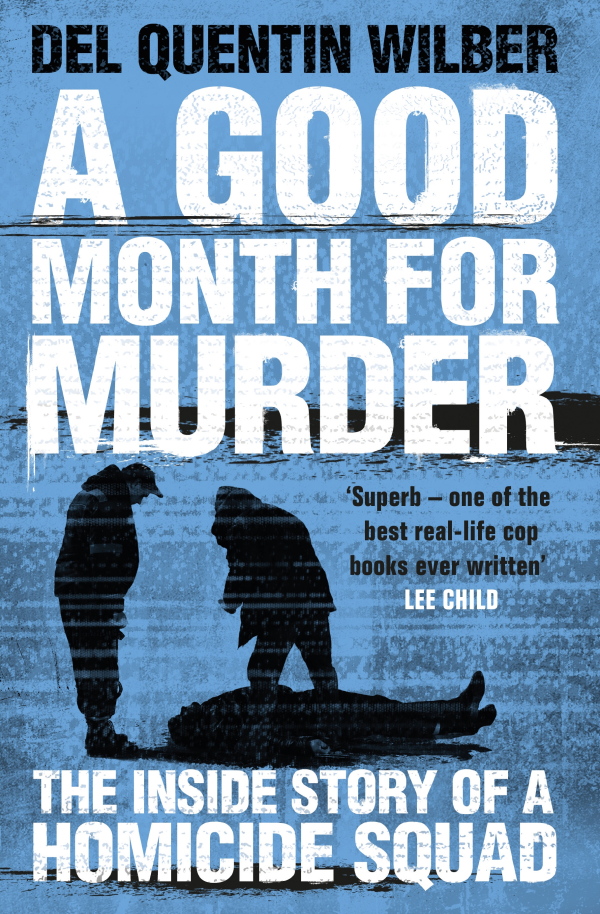
Eurosceptic Crime Fiction: What Now?
Well the results are in, and to the astonishment of practically everyone, the United Kingdom voted to leave the European Union. I’ve been studying and publishing about the rather niche subject of Eurosceptic crime fiction for a few years now, and I’ve made my feelings known about the EU, so you can probably guess the way I voted.
For millions of people throughout the country, myself included, the referendum put a strain on personal and professional relationships. I think we’re all relieved it’s over, even if the vote didn’t go the way we would have wished.
There has been some sour grapes on the Remain side, but I can hardly blame them. I found myself rereading George MacDonald Fraser’s memoir The Light’s on at Signpost (2002) in which he discusses the 1975 referendum in which Britain voted to stay in the EEC:
The holding of a referendum more than a year after entry was a cynical fraud, and not only because it was preceded by a massive campaign to ensure a “yes” vote. The claim that this was a fair procedure was rather like pretending that there is no difference between giving a man on shore a free choice of getting into a boat or remaining on land, and forcing him aboard, rowing him out to sea, and then asking him if he wants to get out or not.
In economic terms, the result has already put a few people out of work, for there is simply no reason to produce any more Eurosceptic thrillers (and only a few titles had been produced so far). Just as the genre looked set to take off, it lost its raison d’être. The question now is will the Eurosceptic genre spread to the continent like the Brexit contagion. We’ve already had one novel from an Icelandic writer, and another by a British writer which was set in Budapest. It’s an inventive, prophesying genre, and it has the potential to spread. It’s worth noting that the last two novels I reviewed, Peter Preston’s 51st State (1998) and Andrew Marr’s Head of State (2014), both accurately predicted Britain would leave the EU in a surprise referendum result. Marr repeated the prediction shortly before the vote.
Judging by their Twitter feeds, I’d guess that a majority of genre writers were in favour of staying in the EU, but the most vocal were the minority of writers who campaigned to leave. I’m thinking particularly of Frederick Forsyth, Tony Parsons and the incomparable Dreda Say Mitchell.
Most of the sensible Leave campaigners struck a conciliatory tone after the vote. I hope we can all agree that we are no less European. After all, the Norwegians and Swiss are every bit as European as the Germans and French, but there is no appetite in Norway or Switzerland to join the EU. Just as the Highland farmer doesn’t want the Westminster MP interfering in his life, ultimately the British people didn’t want to be governed from Brussels.
Final thought: I like to think that PD James would have been very happy with the result.
EU Referendum Thrillers: A Primer
As there is less than a month to go before the referendum in which the British people will decide whether the United Kingdom will leave or remain in the European Union, I thought it was high time I returned to the niche subject of Eurosceptic crime fiction.
The fear that British democracy is being subsumed into a centralised, undemocratic and corrupt EU has proved a fruitful subject for several thriller writers. Some of the Eurosceptic thrillers I have looked at on this blog include Andrew Roberts The Aachen Memorandum (1995) which presents a dystopian view of Britain in the year 2045, now a colony in the United States of Europe. For a contemporary setting read Michael Dobbs A Sentimental Traitor (2011) and Alan Judd’s Uncommon Enemy (2012), both are rattling good yarns with stiff upper lip British heroes battling sinister EU bureaucrats. For Euroscepticism outside of a British setting there is the Icelandic writer Hallur Hallson’s rather heavy-going Vulture’s Lair (2012), and Adam Lebor’s The Budapest Protocol (2009). Lebor’s work is particularly impressively as much of the novel is concerned with exposing the discrimination against the Romani or Roma people in Central and South-Eastern Europe which, I believe, counteracts the claim that Eurosceptics are a right-wing fringe.
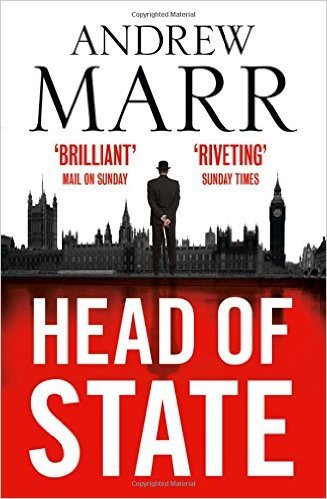
Recently I came across two entertaining works to add to my list, both written by authors who one would not naturally describe as Eurosceptic. First, we have Andrew Marr’s Head of State (2014). Marr’s novel was published a year before the general election in which the Conservative party was returned to government and the EU referendum became inevitable. The plot is rather prescient as events begin three days prior to an EU referendum. The ‘In’ campaign is heavily reliant on the Prime Minister’s personal appeal (sound familiar?) and not on his pre-vote renegotiation, a vague promise to establish a freer-market, which looks like a less regulated EU for the richer northern countries (although that sounds better than what David Cameron actually achieved). But when the Prime Minister suddenly dies, his Euro-fanatical aides hatch a scheme to keep this information from the public unless its derails the expected ‘In’ vote. What follows is utterly preposterous, and if I told you the cast of characters included impressionist Rory Bremner (no really) you can probably guess the shenanigans that ensue.
I described Head of State as entertaining, I didn’t say it was particularly good. It received scathing reviews, none of which I’d argue with. Marr credits Lord Chadlington with giving him the basic plot, and the Tory peer writes a foreword defending the ridiculous narrative ‘we should remember that much of what we take today as ‘normal’ political behaviour would have been considered unthinkable fifty – or even twenty – years ago. Today, almost anything seems politically possible.’ Fair enough, but I hardly think civil servants decapitating the Prime Minister’s corpse and then running around Downing Street with body parts is very likely.
Peter Preston’s 51st State was published in 1998 and is a futuristic satire which possesses remarkable foresight. When Preston was writing, the big debate in UK politics was whether Britain should join the Single Currency. 51st State begins with Brexit: a late intervention by the mild-mannered Tory Leader of the House of Commons Rupert Warner (think Michael Gove) unexpectedly sways the country into voting to leave the EU. The suddenly popular Warner find himself elevated to the role of Prime Minister (think Boris), and Britain needs to rethink its place in the world, and its future. Warner is persuaded by his ambitious colleague Polly Gurley to join a political union with the United States, and Britain becomes the titular 51st State in the world’s only remaining superpower.
51st State is a better novel than Marr’s Head of State, with Preston more self-aware of the absurdities of the plot and producing better satire as a result. Neither writer shows much enthusiasm for the European Union (the Europhile Utopian-tinged views of Edward Heath and Tony Blair disappeared years ago) however, if I was to guess their personal views, they seem glumly resigned to Britain staying in the EU as the best of a collection of bad options.
Having studied Eurosceptic thrillers for a few years now, and reading many views from the other side of the debate, I can’t just resign myself to voting Remain in the knowledge that the EU is becoming more and more unaccountable, bureaucratic and arrogant with power.
I respect Marr and Preston as writers, but I’ll be voting Leave, and long live the Eurosceptic thriller!


